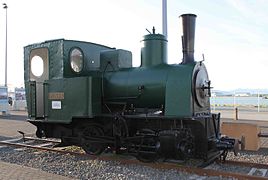Rail transport in Iceland
Rail transport occupies an extreme marginal position in the infrastructure of Iceland . There is no rail transport to transport people in Iceland. Historically there have been three railway systems in Iceland. There were plans for railways with passenger transport from 1906 to 1931. One of the plans was for a railroad from Reykjavík to Selfoss .
Historic railway companies
Reykjavík Port Railway
1913 was a narrow-gauge railway with 900 mm gauge and two together twelve kilometers of trails put into operation. The reason was the expansion of the port in Reykjavík. One stretch led from the port to Öskjuhlið, the other to Skólavörðuholt. The railway was used exclusively for freight traffic . After the construction work was completed in 1917, the railway continued to transport goods until 1928. For this were two steam locomotives of the locomotive factory Arnold Jung from 1892 available, which were bought second-hand.
These locomotives were originally built for R. Dolberg in Rostock , No. 129 was delivered there by Jung on May 19, 1892 and No. 130 on June 3, 1892. Both were sold to NC Momberg in Denmark in 1910, where they received a replacement boiler (No. 129 Kessel 1592 and No. 130 Kessel 1591) and arrived on the island in 1913. Both are preserved in museums, the "Minør" (no. 129) as a monument locomotive in the harbor, the "Pionér" (no. 130) in the open-air museum Árbæjarsafn in Reykjavík. The nameplate of the new boiler is attached to this locomotive - this gives the impression that it is the original nameplate. This makes Iceland the only country in the world where all of the steam locomotives that have ever run there have been kept in a museum.
Korpúlfsstaðir
A material web with a 600 mm track was built on the large-scale agricultural facility in Korpúlfsstaðir in the 1930s . There were no locomotives , the cars were only moved with muscle power. The plant was still in operation in 1993. The large agricultural plant Korpúlfsstaðir has since been abandoned. Today there is a golf course and a school there. Structural remains of the railway system no longer exist.
Kárahnjúkar
At the beginning of the 21st century, the Kárahnjúkar power plant was built in the east of Iceland . For its construction, the Italian construction company Impregilo temporarily rented a narrow-gauge railway, installed it and operated it with diesel locomotives . After the construction work was completed, the railway was dismantled and shipped back to Italy. On this line, there was also the only personal injury railway accident in Iceland, a collision between a train carrying cement and a train carrying personnel. Three workers were injured in the accident.
Ísafjörður
In Ísafjörður you can see a small port railway in the harbor area. Vehicles can be viewed in the port museum. The cars and switches on display show that this railway was operated with muscle power.
Planning a route between Reykjavík and Keflavík Airport
The first plans for the route date from before the Icelandic economic crisis in 2008 and were put on hold. Planning was not resumed until 2013.
A line is being planned that will connect the capital Reykjavík with Keflavík Airport by a single-track, approximately 47-kilometer electrified standard-gauge railway line . The top speed should be 250 km / h, the travel time could be about 18 minutes. The two terminals are to be built at the BSÍ bus station in Reykjavík and at the airport. A stop in Kópavogur is still being checked. Between Reykjavík and Straumsvík, the route is to run for 16 km at a depth of 50 to 160 m in a tunnel . It will be driven on by four multiple units .
Detailed planning including negotiations with general contractors have started. It will take five years to build the line. Traffic could not start until 2025 at the earliest .
So far, planning costs of 3.3 million euros have been spent on the project. There are a number of different figures in circulation for construction costs: ISK 150 billion (around EUR 1.06 billion) and ISK 85 to 100 billion (around EUR 700 to 810 million).
The greatest structural challenge for the project is the tunnel between Reykjavík and Straumsvík, especially since the geological conditions in the area of the future construction site are currently insufficiently known. In this respect, it can be assumed that the start of operations in 2025 is a very optimistic approach. According to press reports from April 2019, construction could start in 2022 at the earliest.
literature
- Bernhard Rieger: Iceland - a country without a railroad? In: EisenbahnGeschichte 37, p. 72.
Web links
- Iceland - country without railways, from BDEF Report 2/2009 (PDF)
- Glenn F. Cartwright: Iceland's Railways. June 30, 2005, archived from the original on March 1, 2012 ; accessed on January 18, 2016 .
- Narrow-gauge railway in Iceland (English)
Individual evidence
- ↑ a b c d jst: Iceland plans airport line . In: Eisenbahn-Revue International 7/2018, p. 368.
- ↑ Kominn með Erlendan fagfjárfesti að Fluglestinni. In: mbl.is. May 27, 2016, Retrieved September 6, 2017 (Icelandic).
- ↑ Work to begin on high-speed train to KEF. In: Iceland monitor. December 15, 2015, accessed September 6, 2017 .
- ^ Vala Hafstað: Airport Train Still a Possibility. In: icelandmonitor.mbl.is. April 3, 2019, accessed April 6, 2019 .





